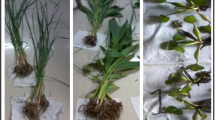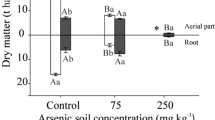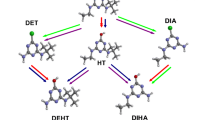Abstract
Introduction
Arsenic (As) can be removed from water via rhizofiltration using phytostabilizing plants. The aim of this study was to investigate the performance of Eleocharis macrostachya in constructed wetland prototypes, as well as the plant's arsenic mass retention and the distribution of As along the wetland flow gradient and the soil in the wetland mesocosmos.
Materials and methods
Experiments were carried out in laboratory-scale wetland prototypes, two planted with E. macrostachya and one without plants. Samples of water were taken at the inlet and outlet of the wetlands during the 33-week test period. At the end of the experiment, plants and soil (silty-sand) from each prototype were divided in three equal segments (entrance, middle and exit) and analyzed for their arsenic content. Results revealed that the planted wetlands have a higher As-mass retention capacity (87–90% of the total As inflow) than prototypes without plants (27%).
Results
As mass balance in the planted wetlands revealed that 78% of the total inflowing As was retained in the soil bed. Nearly 2% was absorbed in the plant roots, 11% was flushed as outflow, and the fate of the remaining 9% is unknown. In the prototype without plants, the soil retained 16% of As mass, 72% of the arsenic was accounted for in the outflow, and 12% was considered unknown. Although E. macrostachya retained only 2% of the total arsenic mass in their roots, its presence was a determining factor for arsenic retention in the wetland soil medium.
Conclusion
Hence, planted wetlands might be a suitable option for treating As-contaminated water.






Similar content being viewed by others
References
Bundschuh J, Litter M, Ciminelli VST, Morgada ME, Cornejo L, Garrido Hoyos S, Hoinkis J, Alarcón-Herrera MT, Armienta MA, Bhattacharya P (2010) Emerging mitigation needs and sustainable options for solving the arsenic problems of rural and isolated urban areas in Latin America: A critical analysis. Water Res 44:5828–5845
Cheng S, Grosse W, Karrenbrock F, Thoennessen M (2002) Efficiency of constructed wetlands in decontamination of water polluted by heavy metals. Ecol Eng 18:317–325
Deng H, Ye ZH, Wong MH (2004) Accumulation of lead, zinc, copper and cadmium by 12 wetland plant species thriving in metal-contaminated sites in China. Environ Pollut 132:29–40
Doyle MO, Otte ML (1997) Organism-induced accumulation of iron, zinc and arsenic in wetland soil. Eviron Pollut 96:1–11
Fang Y, Shen GX, Li XL, Li hz, Hua h, Ni WZ (2011) A comparative study on the potential of oxygen release by roots of selected wetland plants. Phys Chem Earth 36:475–478
Flores TE, Alarcón Herrera MT, González Elizondo S, Olguin EJ (2003) Arsenic tolerating plants from mine sites and hot sprongs in the semi-arid region of Chihuahua, Mexico. Acta Biotechnol 23(2–3):113–119
Frohne T, Rinklebe J, Diaz-Bone R, Du Laing G (2011) Controlled variation of redox conditions in a floodplain soil: impact on metal mobilization and biomethylation of arsenic and antimony. Geoderma 160:414–424
Galleti A, Verlicchi P, Ranieri E (2010) Removal and accumulation of Cu, Ni and Zn in horizontal subsurface flow constructed wetlands: contribution of vegetation and filling medium. Sci Total Environ 408:5097–5105
Greipsson S, Crowder AA (1992) Amelioration of copper and nickel toxicity by iron plaque on roots of rice (Oryza sativa). Can J Bot 70:824–830
Jacob DL, Otte ML (2004) Long-term effects of submergence and wetland vegetation on metals in a 90-year old abandoned Pb-Zn mine tailings pond. Eviron Pollut 130:337–345
Johnson BB, Derosa CT (1970) Arsenic–phosphorus interaction in corn. Commun Soil Sci Plant Anal 1:85–93
Kadlec RH, Knight RL (1996) Treatment wetlands. CRC Press, Boca Raton, FL, p 893
Kidd P, Barcelo J, Pilar Bernal M, Navari-Izzo F, Poschenrieder C, Shilev S, Clemente R, Monterroso C (2009) Trace element behaviour at the root–soil interface: implications in phytoremediation. Environ Exp Bot 67:243–259
Koottatep T, Polprasert C, Koanh NT, Heinss U, Montangero A, Strauss M (2001) Septage dewatering in vertical-flow constructed wetlands located in the tropics. Water Sci Technol 44(2–3):181–188
Kosopolov VD, Kuschk P, Vainsthein MB, Vatsourina AV, Wiebner M, Kastner M (2004) Microbial processes of heavy metal removal from carbon-deficit effluents in constructed wetlands. Eng Life Sci 4:403
Li H, Ye ZH, Wei ZJ, Wong MH (2011) Root porosity and radial oxygen loss related to arsenic tolerance and uptake in wetland plants. Environ Pollut 159:30–37
Lu LL, Tian SK, Yang XE, Li TQ, He ZL (2009) Cadmium uptake and xylem loading are active processes in the hyperaccumulator Sedum alfredii. J Plant Physiol 166:579–587
Núñez-Montoya OG, Alarcón-Herrera MT, Melgoza-Castillo A, Rodríguez-Almeida FA, Royo-Márquez MH (2007) Evaluation of three native species from Chihuahua desert for use in phytoremediation. Terra Latinoam 25:35
Otte ML, Kearns CC, Doyle MO (1995) Accumulation of arsenic and zinc in the rhizosphere of wetland plants. Bull Environ Contam Toxicol 55:154–161
Overesch M, Rinklebe J, Broll G, Neue HU (2007) Metals and arsenic in soils and corresponding vegetation at Central Elbe river floodplains (Germany). Environ Pollut 145:800–812
Rahman MA, Hasegawa H, Ueda K, Maki T, Rahman MM (2008) Arsenic uptake by aquatic macrophyte Spirodela polyrhiza L.: interactions with phosphate and iron. J Hazard Mater 160(23):356–361
Rahman KZ, Wiessner A, Kuschk P, Afferden M (2011) Fate and distribution of arsenic in laboratory-scale subsurface horizontal-flow constructed wetlands treating an artificial wastewater. Ecol Eng, in press
Robinson B, Duwig C, Bolan N, Kannathasan M, Saravanan A (2003) Uptake of arsenic by New Zealand water cress (Lepidium sativum). Sci Total Environ 301:67–73
Shanker AK, Cervantes C, Loza-Tavera H, Avudainayagam S (2005) Chromium toxicity in plants. Environ Int 31:739–753
Singhakant C, Koottatep T, Satayavivad J (2009) Enhanced arsenic removals through plant interactions in subsurface-flow constructed wetlands. J Environ Sci Health (Part A) 44:163–169
Sobolewsky A (1999) A review of processes responsible for metal removal in wetlands treating contaminated mine drainage. Int J Phytoremediat 1:19–51
Stottmeister U, Wießner A, Kuschk P, Kappelmeyer U, Kästner M, Bederski O, Müller RA, Moormann H (2003) Effects of plants and micro-organisms in constructed wetlands for wastewater treatment. Biotechnol Adv 22:93–117
Ujang Z, Soedjono E, Shutes RB (2005) Landfill leachate treatment by an experimental subsurface constructed wetland in tropical climate countries. Water Sci Technol 52:243
Vymazal J (2005) Removal of heavy metals in a horizontal sub-surface flow constructed wetland. J Environ Sci Health Part A 40:1369–1379
Xu XY, McGrath SP, Zhao FJ (2007) Rapid reduction of arsenate in the medium mediated by plant roots. New Phytol 176:590–599
Ye ZH, Lin ZQ, Whiting SN, De Souza MP, Terry N (2003) Possible use of con- structed wetland to remove selenocyanate, arsenic, and boron from electric utility wastewater. Chemosphere 52:1571–1579
Yong RN (1995) The fate of toxic pollutants in contaminated sediments. In: Demars KR, Richardson GN, Yong RN, Chaney RC (eds) Dredging, remediation, and containment of contaminated sediments. ASTM STP, vol. 1293. American Society for Testing and Materials, Philadelphia, pp. 13–39
Zhao FJ, Ma JF, Mehargand AA, McGrath SP (2009) Arsenic uptake and metabolism in plants. New Phytol 181:777–794
Acknowledgements
The present study was developed with the support of Fondos Mixtos del Estado de Chihuahua, under the project entitled “Monitoring Fluoride and Arsenic in the Aquifer of the Delicias-Meoqui-Julimes in the State of Chihuahua and Review of the Removal Processes” Project No: Chih-2008 C02 91833. The authors also thank the people in charge of the Soils Laboratory at the College of Engineering, Autonomous University of Chihuahua, and the personal from chemistry and water quality Laboratories in CIMAV for all the arsenic determinations and their kind support. The translation and revision of this paper were made possible by Daniel and Leonardo Martín-Alarcón.
Author information
Authors and Affiliations
Corresponding author
Additional information
Responsible editor: Elena Maestri
Rights and permissions
About this article
Cite this article
Olmos-Márquez, M.A., Alarcón-Herrera, M.T. & Martín-Domínguez, I.R. Performance of Eleocharis macrostachya and its importance for arsenic retention in constructed wetlands. Environ Sci Pollut Res 19, 763–771 (2012). https://doi.org/10.1007/s11356-011-0598-x
Received:
Accepted:
Published:
Issue Date:
DOI: https://doi.org/10.1007/s11356-011-0598-x




